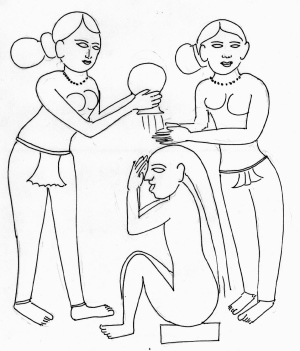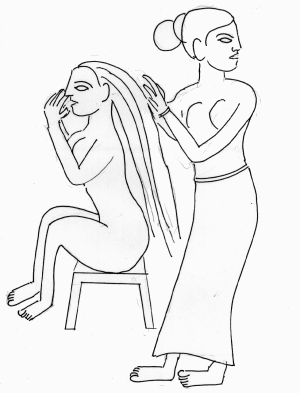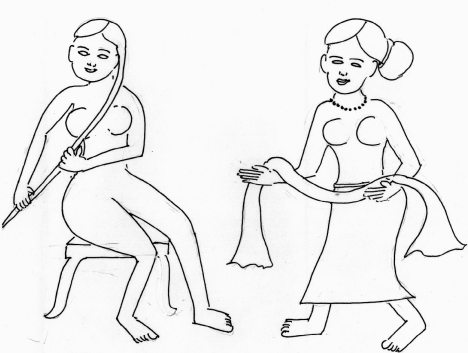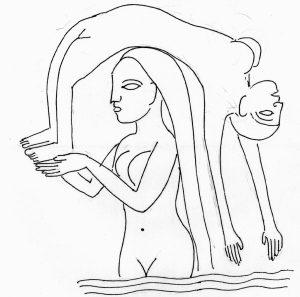History of Bathing in Karnataka
by Jyotsna Kamat
Illustrations by K. L. Kamat based on temple sculptures
and period paintings
Abstract of paper presented at the Sirsi History Conference, 1998
Abstract
Over the centuries, the people of Karnataka (map - topics - pictures) have given equal importance to mental and physical hygiene. A twelfth century encyclopedic text, "Manasollasa", gives details of scientific approaches to bathing (see also: Manasollasa on sex). A seventeenth century handbook written primarily for royalty, "Sivatatvaratnakara" also provides similar details about bathing. The "Agnipurana" describes eight modes of attending to physical cleansing. Govindavaidya's "Kanthiravanarasarajavijaya" gives a very picturesque description of a bathing ghat (public bath on a river-bank) and describes the incessant water supply available for bathing throughout the year. An inscription refers to provisions made for oil baths for the students of Talagunda Agrahara and another makes special mention of the grant of an oil mill for the production of oil for the scholars of Samyana Mathika. Domingo Paes (1520-21 A.D.) describes the physical regimen and oil baths of Krishnadevaraya of the Vijayanagar empire. Here is a collection of pictures depicting bathing and grooming from medieval Karnataka
© K. L. Kamat

Man being assisted by two women to wash long hair.
Line drawing based on a sculpture at Nad kalse
Sculptors and artists have left behind a number of illustrations of various types of bathing methods prevalent in their times. Examples of such sculptures are found in the Mallikarjuna temple (1278 A.D.) of Nad Kalse in the Sagar taluk (sub-district) of Shimoga district. Similar sculptures are also seen at the Khetappayya Narayan temple, Bhatkal (1546 A.D.) in Uttara Kannada district. In "Sougandhikaparinaya" (1825 A.D.) a book printed in stone, the artists took pains to illustrate the bathing activities of ladies who accompanied the kings to their forest camps.
© K. L. Kamat

Lady having an oil bath
Line drawing based on a painting from Nad Kalse
© K. L. Kamat

A housewife receives a towel after her bath
Line drawing based on a Bhatkal sculpture
(See also: Everyday Bhatkal -- Research paper on depiction of everyday life in a 16th century temple sculptures of Bhatkal town.)
© K. L. Kamat

Aquatic acrobatics
Illustration based on Sougandhikaparinaya, an ancient text
![]()
See Also:
-
Old Time Parties -- Drinking habits of men and women of Karnataka as described in medieval texts and sculptures.
-
Jai Karnataka -- Potpourri of topics on Karnataka's history, people, folklore and arts. Includes sub-sections on Mysore, Karavali, and North Karnataka.

